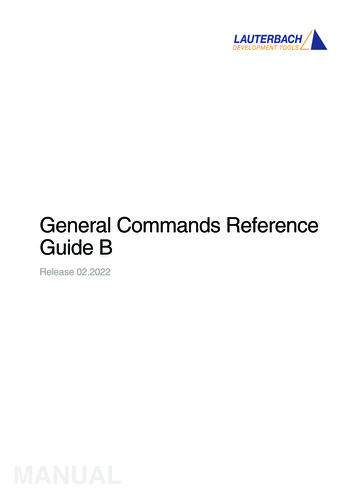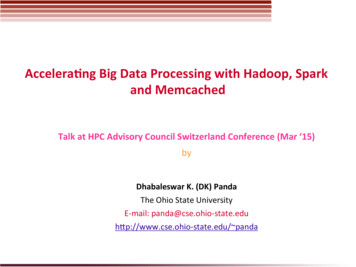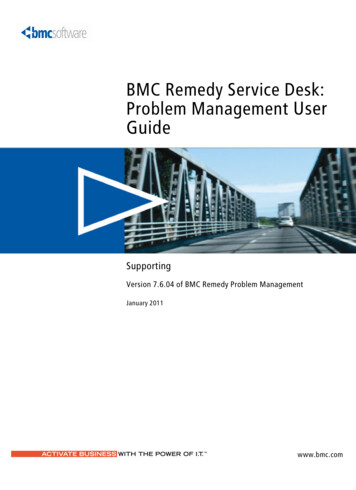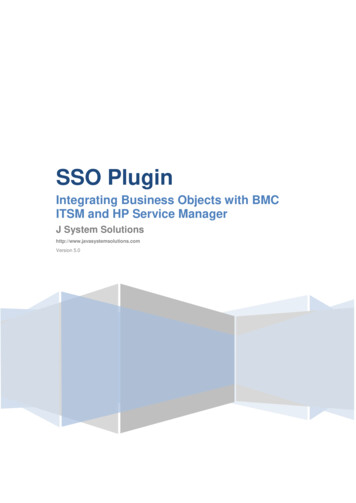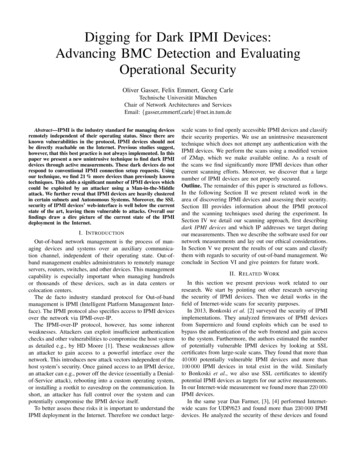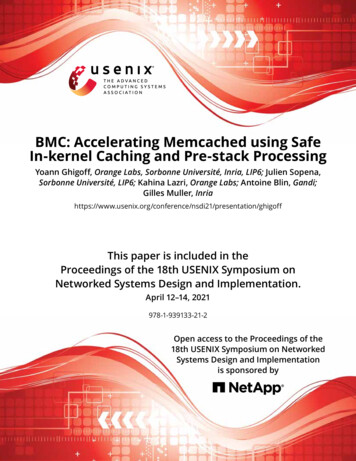
Transcription
BMC: Accelerating Memcached using SafeIn-kernel Caching and Pre-stack ProcessingYoann Ghigoff, Orange Labs, Sorbonne Université, Inria, LIP6; Julien Sopena,Sorbonne Université, LIP6; Kahina Lazri, Orange Labs; Antoine Blin, Gandi;Gilles Muller, entation/ghigoffThis paper is included in theProceedings of the 18th USENIX Symposium onNetworked Systems Design and Implementation.April 12–14, 2021978-1-939133-21-2Open access to the Proceedings of the18th USENIX Symposium on NetworkedSystems Design and Implementationis sponsored by
BMC: Accelerating Memcached using Safe In-kernel Caching andPre-stack ProcessingYoann GhigoffOrange LabsSorbonne Université, LIP6, InriaJulien SopenaSorbonne Université, LIP6Kahina LazriOrange LabsAntoine BlinGandiGilles MullerInriaAbstractIn-memory key-value stores are critical components thathelp scale large internet services by providing low-latencyaccess to popular data. Memcached, one of the most popular key-value stores, suffers from performance limitationsinherent to the Linux networking stack and fails to achievehigh performance when using high-speed network interfaces.While the Linux network stack can be bypassed using DPDKbased solutions, such approaches require a complete redesignof the software stack and induce high CPU utilization evenwhen client load is low.To overcome these limitations, we present BMC, an inkernel cache for Memcached that serves requests before theexecution of the standard network stack. Requests to the BMCcache are treated as part of the NIC interrupts, which allowsperformance to scale with the number of cores serving theNIC queues. To ensure safety, BMC is implemented usingeBPF. Despite the safety constraints of eBPF, we show that itis possible to implement a complex cache service. BecauseBMC runs on commodity hardware and requires modificationof neither the Linux kernel nor the Memcached application, itcan be widely deployed on existing systems. BMC optimizesthe processing time of Facebook-like small-size requests. Onthis target workload, our evaluations show that BMC improvesthroughput by up to 18x compared to the vanilla Memcachedapplication and up to 6x compared to an optimized versionof Memcached that uses the SO REUSEPORT socket flag.In addition, our results also show that BMC has negligibleoverhead and does not deteriorate throughput when treatingnon-target workloads.1IntroductionMemcached [24] is a high-performance in-memory key-valuestore used as a caching-service solution by cloud providers [1]and large-scale web services [5, 40]. Memcached allows suchservices to reduce web request latency and alleviate the loadon backend databases by using main memory to store andserve popular data over the network.USENIX AssociationMemcached, however, is prone to bottlenecks introducedby the underlying operating system’s network stack, including Linux’s [16, 36], since the main goal of general purposeoperating systems is to provide applications with flexible abstractions and interfaces. To achieve high throughput and lowlatency, user applications can give up using the standard kernel interfaces by using kernel-bypass technologies such asDPDK [6] which allow an application to program networkhardware and perform packet I/O from userspace. The application that has control of the network hardware is thenresponsible for implementing a network stack that fits itsspecific needs [14, 28]. However, kernel-bypass comes withdrawbacks. First, it eliminates security policies enforced bythe kernel, such as memory isolation or firewalling. Specifichardware extensions, i.e. an IOMMU and SR-IOV [15, 20],or software-based isolation are then required to maintain standard security levels. Second, kernel-bypass relies on dedicating CPU cores to poll incoming packets, trading off CPUresources for low latency. This prevents the cores from beingshared with other applications even when the client load is low.Third, kernel-bypass requires an extensive re-engineering ofthe existing application in order to achieve high performancewith a dedicated network stack.In this paper, we propose BPF Memcached Cache (BMC)to address the kernel bottlenecks impacting Memcached.BMC focuses on accelerating the processing of small GETrequests over UDP to achieve high throughput as previouswork from Facebook [13] has shown that these requests makeup a significant portion of Memcached traffic. Contrary tohardware-specific accelerators, BMC runs on standard hardware and thus can be deployed on infrastructure with heterogeneous hardware. BMC relies on a pre-stack processingapproach that consists in intercepting requests directly fromthe network driver, before they are delivered to the standardnetwork stack, and processing them using an in-kernel cache.This provides the ability to serve requests with low latencyand to fall back to the Memcached application when a requestcannot be treated by BMC. BMC can leverage modern network card features such as multi-queues to process multiple18th USENIX Symposium on Networked Systems Design and Implementation487
requests in parallel (see Figure 1). In addition, BMC usesa separate lock for each cache entry to introduce minimaloverhead and allow performance to scale with the number ofcores.Running BMC at the kernel level raises safety issues as abug in its implementation could put the entire system at risk.To address this issue, BMC is implemented using eBPF. TheBerkeley Packet Filter (BPF) [37], and its extended version,eBPF, is a bytecode and a safe runtime environment offeredby the Linux kernel to provide userspace an approach to inject code inside the kernel. The Linux kernel includes a staticanalyzer to check that the injected code is safe before it canbe executed, which limits the expressiveness of the injectedcode. We show how to circumvent this limitation by partitioning complex functionality into small eBPF programs andby bounding the data that BMC processes. Using eBPF alsoallows BMC to be run without requiring any modification tothe Linux kernel or to the Memcached application, makingit easy to deploy on existing systems. The eBPF bytecode ofBMC is compiled from 513 lines of C code and is JIT compiled by the Linux kernel. This results in BMC introducingvery little overhead into the OS network stack.Memcached The evaluation of BMC under a non-target workloadthat consists of large requests not processed by BMC. Inthis setting, BMC has negligible overhead and does notdeteriorate throughput with respect to MemcachedSR. The comparison of BMC with a dummy cache that showsthat BMC’s design is well suited for high throughputperformance as it does not introduce unnecessary complexity. The comparison of Memcached running with BMCagainst a Memcached implementation based on Seastar,a networking stack for DPDK [6]. Our results show thatMemcached with BMC achieves similar throughput toSeastar but uses 3x less CPU resources.The rest of this paper is organized as follows. Section 2provides background on Memcached and the OS networkstack bottlenecks it suffers from. Section 3 describes BMCand its design. Section 4 discusses implementation details.Section 5 presents the experimental results. Section 6 discusses the generalization of BMC and its memory allocationchallenges. Section 7 presents related work. Finally, Section 8concludes the paper.2Background and motivationSocket erNetworkdriverRXcoreRXcoreRXcoreRXcoreNetwork interface cardFigure 1: General architectureThe main results of this paper include: The identification of the bottlenecks of Memcachedwhen processing requests over UDP. We propose MemcachedSR, a modified version of Memcached that usesthe SO REUSEPORT socket option to scale with thenumber of threads, improving throughput by 3x compared to the vanilla Memcached. The evaluation of BMC under our target workload consisting of small requests. In this setting, BMC improves the throughput by up to 6x with respect to MemcachedSR and by up to 18x with respect to vanilla Memcached.488This section describes the limitations of Memcached thatmotivate our work, and describes the eBPF runtime used toimplement BMC.2.1MemcachedMemcached [10] is a mature in-memory key-value store traditionally used as a cache by web applications in a datacenterenvironment to speed up request processing and reduce theload on back-end databases. Because of its popularity, a lotof work has been put into optimizing it [35, 44].A Memcached server operates on items, which are objectsused to store a key and its associated value and metadata.Clients send requests to a Memcached server using a basiccommand-based protocol, of which GET and SET are themost important commands. A GET key command retrievesthe value associated with the specified key if it is stored byMemcached and a SET key value command stores the specified key-value pair. A GET command can also be used asa multiget request when a client needs to retrieve multiplevalues at once. Requests can be sent using either the TCP orthe UDP transport protocol.The data management of Memcached has been well optimized and relies on slab allocation, a LRU algorithm anda hash table to allocate, remove and retrieve items stored inmemory. Previous studies [16, 30] have shown that Memcached performance and scalability are heavily impaired byOS network stack bottlenecks, especially when receiving alarge number of small requests. Since Facebook’s production18th USENIX Symposium on Networked Systems Design and ImplementationUSENIX Association
workloads show a 30:1 distribution between GET and SETcommands, Nishtala et al. [40] proposed using UDP instead ofTCP for GET commands to avoid the cost of TCP processing.To gain additional insight into the performance of a Memcached server using UDP to receive GET requests, we profiled the CPU consumption while trying to achieve maximumthroughput (the experimental setup is described in Section 5).As shown in Figure 2, more than 50% of Memcached’s runtime is spent executing system calls. Moreover, the CPUusage of both sys recvfrom and sys sendmsg increases asmore threads are allocated to Memcached. When eight threadsare used by Memcached, the total CPU usage of these threesystem calls reaches 80%.CPU usage (%)5040302010012345678# of threadslock contention. As shown in Figure 3, MemcachedSR scaleswith the number of threads and achieves a throughput that isup to 3 times higher than the vanilla version of Memcached.Despite the scalability of MemcachedSR, there is still roomfor improvement as Memcached requests still have to gothrough the whole network stack before they can be processedby the application.Functionnative queued spin lock slowpathudp enqueue schedule skbclear page ermsudp4 lib lookup2raw spin lockfib table lookupnapi gro receivenfp net rxi40e napi polludp queue rcv one skb% CPU 97%1.32%1.14%Table 1: Top ten most CPU-consuming functions on a Memcached server under network loadFigure 2: CPU usage of the three most used system calls byMemcachedFigure 3 shows the throughput of the vanilla Memcachedapplication when varying the number of threads (and cores).The results show that vanilla Memcached does not scaleand that its performance even deteriorates when more thanfour threads are used. Table 1 shows the top ten most timeconsuming functions measured by the perf tool while running Memcached with eight threads, all of them are kernel functions. The native queued spin lock slowpath andudp enqueue schedule skb functions account for a totalof 28.63% of the processing time of our machine under testand are used to push packets to the UDP socket queue. Thekernel’s socket queues are data structures shared between theMemcached threads and the kernel threads responsible forthe execution of the network stack, and therefore require lockprotection. In the case of Memcached, a single UDP socketis used and its queue is shared between the cores receivingpackets from the NIC and the cores running the application,leading to lock contention. This lock contention is then responsible for the decrease in Memcached throughput.To allow Memcached to scale with the number of threads,we have modified the version 1.5.19 of Memcached to usethe SO REUSEPORT socket option. The SO REUSEPORToption allows multiple UDP sockets to bind to the same port.We refer to this modified Memcached as MemcachedSR inthe rest of the paper. We use this option to allocate a UDPsocket per Memcached thread and bind each socket to thesame port. Received packets are then equitably distributedbetween each socket queue by the Linux kernel which reducesUSENIX AssociationThroughput (KReq/s)sys epoll wait sys recvfrom sys sendmsg1,2001,0008006004002000vanilla Memcached MemcachedSR12345678# of threads and coresFigure 3: Vanilla Memcached vs. MemcachedSR2.2eBPFThe Berkeley Packet Filter (BPF) [37] is an in-kernel interpreter originally designed to run packet filters from userspaceusing a reduced instruction set. BPF has evolved into the extended BPF (eBPF), which introduces a new bytecode andjust-in-time compilation for improved performance. An eBPFprogram can be loaded from userspace by the Linux kerneland triggered by a specific kernel event. The eBPF programis then run whenever the event is triggered.eBPF programs can maintain and access persistent memorythanks to kernel data structures called BPF maps. Maps aredesigned to store arbitrary data structures whose size must bespecified by the user application at creation time. They can beused for communicating between different eBPF programs orbetween eBPF programs and user applications. Furthermore,eBPF programs can call a restricted set of kernel functions,called helpers, allowing eBPF programs to interact with thesystem and access specific kernel data (e.g. map data, time18th USENIX Symposium on Networked Systems Design and Implementation489
since boot up). Tail calls allow an eBPF program to callanother eBPF program in a continuation-like manner. TheeBPF bytecode backend is supported by the Clang/LLVMcompiler toolchain, which allows using the C language towrite eBPF programs in a high-level language.Because running user-space code inside the kernel canimpact the system’s security and stability, the Linux kernelcalls the in-kernel eBPF verifier every time it loads an eBPFprogram to check if the program can be safely attached andexecuted. The goal of the verifier is to guarantee that theprogram meets two properties: safety, i.e., the program neitheraccesses unauthorized memory, nor leaks kernel information,nor executes arbitrary code, and liveness, i.e., the executionof the program will always terminate.To analyze an eBPF program, the verifier creates an abstractstate of the eBPF virtual machine [9]. The verifier updates itscurrent state for each instruction in the eBPF program, checking for possible out-of-bounds memory accesses or jumps.All conditional branches are analyzed to explore all possibleexecution paths of the program. A particular path is valid ifthe verifier reaches a bpf exit instruction and the verifier’sstate contains a valid return value or if the verifier reaches astate that is equivalent to one that is known to be valid. Theverifier then backtracks to an unexplored branch state andcontinues this process until all paths are checked.Because this verification process must be guaranteed toterminate, a complexity limit is enforced by the kernel and aneBPF program is rejected whenever the number of exploredinstructions reaches this limit. Thus, the verifier incurs falsepositives, i.e. it can reject eBPF programs that are safe. InLinux 5.3, the kernel version used to implement BMC, thislimit is set to 1 million instructions. Other parameters, suchas the number of successive branch states, are also used tolimit path explosion and the amount of memory used by theverifier. Since Linux 5.3, the verifier supports bounded loopsin eBPF programs by analyzing the state of every iteration ofa loop. Hence, the verifier must be able to check every loopiteration before hitting the previously-mentioned instructioncomplexity limit. This limits the number of loop iterations aswell as the complexity of the instructions in the loop body.Moving data of variable lengths between legitimate memorylocations requires a bounded loop and conditional instructionsto provide memory bounds checking, which in turn increasethe complexity of an eBPF program. Finally, eBPF does notsupport dynamic memory allocation, instead eBPF programshave to rely on eBPF maps (array, hashmap) to hold a fixednumber of specific data structures.Because of all these limitations, eBPF is currently mostlyused to monitor a running kernel or to process low-layer protocols of network packets (i.e. L2-L4). Processing applicationprotocols is more challenging but is required to allow theimplementation of more complex network functions [38].4903DesignIn this section, we present the design of BMC, a safe in-kernelaccelerator for Memcached. BMC allows the acceleration of aMemcached server by caching recently accessed Memcacheddata in the kernel and by relying on a pre-stack processingprinciple to serve Memcached requests as soon as possibleafter they have been received by the network driver. Thisapproach allows BMC to scale to multicore architectures byleveraging modern NIC’s multi-queue support to run BMC oneach individual core for each received packet. The executionof BMC is transparent to Memcached, and Memcached doesnot need any modification to benefit from BMC. In the rest ofthis section, we first present the pre-stack processing approach.We then describe the BMC cache and how its coherence isinsured.3.1Pre-stack processingBMC intercepts network packets at the network-driver levelto process Memcached requests as soon as possible after theyhave been received by the NIC. BMC filters all network packets received by the network driver based on their destinationport to only process Memcached network traffic. It focuseson processing GET requests using the UDP protocol and SETrequests using the TCP protocol. Figure 4 illustrates how prestack processing allows BMC to leverage its in-kernel cacheto accelerate the processing of Memcached requests.When processing a GET request (4a), BMC checks its inkernel cache and sends back the corresponding reply if it findsthe requested data. In that case, the network packet containingthe request is never processed by the standard network stack,nor the application, freeing CPU time.SET requests are processed by BMC to invalidate the corresponding cache entries and are then delivered to the application (4b). After a cache entry has been invalidated, asubsequent GET request targeting the same data will not beserved by BMC but rather by the Memcached application.BMC always lets SET requests go through the standard network stack for two reasons. First, it enables reusing the OSTCP protocol implementation, including sending acknowledgments and retransmitting segments. Second, it ensures SETrequests are always processed by the Memcached applicationand that the application’s data stays up-to-date. We choosenot to update the in-kernel cache using the SET requests intercepted by BMC because TCP’s congestion control mightreject new segments after its execution. Moreover, updatingthe in-kernel cache with SET requests requires that both BMCand Memcached process SET requests in the same order tokeep the BMC cache consistent, which is difficult to guaranteewithout a overly costly synchronization mechanism.When a miss occurs in the BMC cache, the GET requestis passed to the network stack. Then, if a hit occurs in Memcached, BMC intercepts the outgoing GET reply to update itscache (4c).18th USENIX Symposium on Networked Systems Design and ImplementationUSENIX Association
issNICSet TCPGet UDP(a) Lookup(b) InvalidationNICGet UDP(c) UpdateFigure 4: BMC cache operationsPre-stack processing offers the ability to run BMC on multiple cores concurrently. BMC can benefit from modern NICfeatures such as multi-queue and RSS to distribute processing among multiple CPU cores. The set of cores used torun BMC can also be fine-tuned in order to share a precisememory level (CPU caches, NUMA node, etc.). The performance of BMC can efficiently scale by configuring NICsto use multiple RX queues and mapping them to differentcores. Pre-stack processing also enables running specializedcode without having to modify existing software. Contrary tokernel-bypass, this approach does not require a whole NICto be given to a userspace process and other applications canshare the network hardware through the kernel network stackas usual.4ImplementationThis section explains how BMC deals with the eBPF limitations to meet the required safety guarantees.4.1The verification of a loop contained in a single program mayhit the maximum number of eBPF instructions the verifier cananalyze. Loop complexity depends on the number of iterations and the complexity of the body. To make the verificationof loops possible, BMC bounds the data it can process. Itfirst limits the length of Memcached keys and values. BMCuses a loop to copy keys and values from a network packetto its cache, and vice-versa. For every memory copy, BMCmust guarantee that it neither overflows the packet bounds noroverflows the cache memory bounds using fixed data bounds.Bounds checking then increases the loop complexity. To ensure the complexity of a single eBPF program does not exceedthe maximum number of instructions the verifier can analyze,we empirically set the maximum key length BMC can processto 250 bytes and the maximum value length to 1000 bytes.Requests containing keys or values that exceed these limitsare transmitted to the Memcached application. We also limitto 1500 the number of individual bytes BMC can read froma packet’s payload in order to parse the Memcached data,bounding the complexity of this process. According to Facebook’s workload analysis [13], about 95% of the observedvalues were less than 1000 bytes. Moreover, the Memcachedprotocol sets the maximum length of keys to 250 bytes. Hence,bounding the BMC data size does not have a big practicalimpact.4.23.2BMC cacheThe BMC cache is designed as a hash table indexed by Memcached keys. It is a direct-mapped cache, meaning that eachbucket in the hash table can only store one entry at a time.BMC uses the 32-bit FNV-1a [21] hash function to calculatethe hash value. Because this is a rolling hash function thatoperates on a single byte at a time, it allows BMC to computethe hash value of a key while parsing the Memcached request.The hash value is reduced to an index into the cache tableby using the modulo operator. Each cache entry contains avalid bit, a hash value, a spin lock, the actual stored data, andthe size of the data. This cache design offers constant-timecomplexity for lookup, insertion, and removal operations. Tovalidate a cache hit, BMC checks that the valid bit of a cacheentry is set and that the stored key is the same as that of theprocessed request.The BMC cache is shared by all cores and does not requirea global locking scheme since its data structure is immutable.However, each cache entry is protected from concurrent access using a spin lock.USENIX AssociationBounding dataSplitting complex functionsIn order to avoid reaching the limits of the eBPF verifier,BMC’s functional logic is separated into multiple small eBPFprograms, as each eBPF program is checked for safety independently. Each program then relies on tail calls to jumpto the next program and continue packet processing withoutinterruption. Linux limits the maximum number of successivetail calls to 33, preventing infinite recursion. However BMCuses at most three successive tail calls.BMC is implemented using seven eBPF programs thatare written in C code and are compiled to eBPF bytecodeusing Clang/LLVM version 9 and the default eBPF instructionset. The processing logic of BMC is split into two chains:one chain is used to process incoming Memcached requestsand the other is used to process outgoing replies. Figure 5illustrates how BMC’s eBPF programs are divided. BMC’seBPF programs consist of a total of 513 lines of C code.4.2.1Incoming chainThe incoming chain is composed of five eBPF programs.It is attached to the XDP [27] driver hook and is executed18th USENIX Symposium on Networked Systems Design and Implementation491
Program name# of eBPF instructions# of analyzed instructionsanalysis time (µs)# of CPU instructionsrx filterhash keysprepare packetwrite replyinvalidate cachetx filterupdate cache871421783301636112531 503787 898181398 044518 32172345 33211 130290 58847132 952246 7884395 615152218212414224104188Table 2: Complexity of BMC’s programs. Column 2 represents the number of eBPF bytecode instructions of the programcompiled from C code. Columns 3 and 4 respectively show the number of eBPF bytecode instructions processed by the Linuxverifier and the time spent for this analysis. Column 5 shows the number of CPU instructions after JIT compilation.MemcachedNetwork stackTrafic Control hookBMC MissBMC Hithash keysinvalidate cacheprepare packetwrite replyBMCtx filterrx filterupdate cacheXDP hookNetwork Device DriverFigure 5: Division of BMC into seven eBPF programswhenever a new packet is processed by the network driver.This hook is the earliest point in the network stack at whichan eBPF program can be attached and allows BMC to use prestack processing to save the most CPU cycles by respondingto Memcached requests as soon as possible.rx filter. The goal of this first eBPF program is to filterpackets corresponding to the Memcached traffic using tworules. The first rule matches UDP packets whose destination port corresponds to Memcached’s and whose payloadcontains a GET request. The second rule matches TCP traffic whose destination port also corresponds to Memcached’s.The incoming chain branches based on which rule matches. Ifneither rule matches, the packet is processed by the networkstack as usual.hash keys. This program computes hashes for every Memcached GET key contained in the packet. It then checks thecorresponding cache entries for any cache hit or hash collisionand saves the key hashes that have been hit in a per-cpu arrayused to store context data for the execution of the chain.prepare packet. This eBPF program increases the sizeof the received packet and modifies its protocol headers toprepare the response packet, swapping the source and destination Ethernet addresses, IP addresses and UDP ports. Itthen calls the last eBPF program of this branch of the chain.492The maximum number of bytes BMC can add to the packet islimited by the network driver implementation. In our currentimplementation of BMC, this value is set to 128 bytes basedon the different network drivers BMC attaches to, and it canbe increased to a higher value to match other network driverimplementations.write reply. This eBPF program retrieves a key hash savedin the per-cpu array to copy the corresponding cache entryto the packet’s payload. If the table contains multiple keyhashes, this eBPF program can call itself to copy as manyitems as possible in the response packet. Finally, this branchof the incoming chain ends by sending the packet back to thenetwork.invalidate cache. The second branch of the incomingchain handles Memcached TCP traffic and contains a single eBPF program. This program looks for a SET requestin the packet’s payload and computes the key hash when itfinds one to invalidate the corresponding cache entry. Packetsprocessed by this branch of the incoming chain are alwaystransmitted to the network stack so that Memcached can receive SET requests and update its own data accordingly.4.2.2Outgoing chainThe outgoing chain is composed of two eBPF programs toprocess Memcached responses. It is attached to the TrafficControl (TC) egress hook and is executed before a packet issent to the network.tx filter. The first eBPF program of this chain serves as apacket filter and applies a single rule on outgoing packets. Therule matches UDP packets whose source port corresponds toMemcached’s. In this case the second eBPF program of thechain is called, otherwise the packet is sent to the network asusual.update cache. The second eBPF program checks if thepacket’s payload contains a Memcached GET response. Ifpositive, its key is used to index the BMC cache and the response data is copied in the corresponding cache entry. Thenetwork stack then carries on its execution and the Memcached response is sent back to the network.18th USENIX Symposium on Networked Systems Design and ImplementationUSENIX Association
Table 2 provides complexity metrics for each eBPF program. For the most complex ones, the number of eBPF instructions the Linux verifier has to analyze to ensure theirsafety is a thousand times higher than their actual number ofinstructions. The table also shows that it is necessary to divideBMC’s logic into multiple eBPF programs to avoid reachingthe limit of 1,000,000 instructions that can be analyzed by theLinux verifier.5EvaluationIn this section, we evaluate the performance of MemcachedSRrunning with BMC. We aim to evaluate the throughput gainoffered by BMC and how performance scales with the numberof cores when processing a target workload that consists ofsmall UDP requests. We also evaluate MemcachedSR withBMC on a non-target workload to study the overhead andimpact of BMC on throughput when it intercepts Memcachedrequests but does not cache them. We show that the increasein throughput can be obtained without allocating additionalmemory, and that the cache memory can be partitioned between the Memcached application and BMC. We compareBMC with a dummy cache implementation and show that itsdesign is efficient for
store used as a caching-service solution by cloud providers [1] and large-scale web services [5,40]. Memcached allows such . and to fall back to the Memcached application when a request cannot be treated by BMC. BMC can leverage modern net- . The data management of Memcached has been well op-timized and relies on slab allocation, a LRU .
